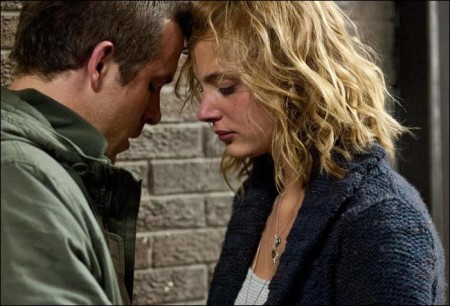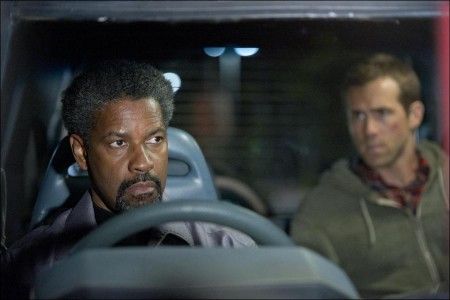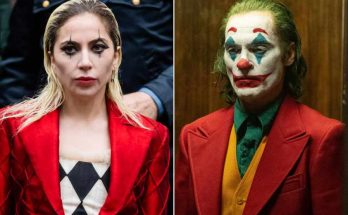For Denzel Washington and Ryan Reynolds, the early call to set-nearly a month prior to commencement of principal photography-was a gift. In addition to the heavy prep a movie of this scale entails, it provided the performers and their colleagues with the opportunity to discover the eccentricities of their characters.
Beyond motivation, however, many in the cast were called upon to take part in world-class action and breathless stunts. Stuber explains: “There are gun fights, car chases, hand-to-hand fights, knife fights. That takes an army of people spending day after day working hard to make it all happen believably and safely. That’s a real credit to these actors and stunt performers. They worked on their weekends with their knee pads and chest plates to perfect the intense and complicated moves.”
The director praises the one he believes is largely responsible for bringing the complex action sequences to life: stunt coordinator Powell. “Greg is a genius,” says Espinosa. “He comes from a generation of stunt coordinators who have it in their blood, and their imagination is endless. It was fun to watch them create a sense of gravity. We had a car, for example, with a professional stunt driver on top [LEE MILLAM], with the actor inside the car pretending to drive. When I was in the car, it felt like you could hit the wall at any second, but it was quite safe.”
Once Weston and Frost flee the destroyed safe house in a late-model BMW, Weston tries to outmaneuver Vargas and his men through the roads of Cape Town. Before taking to the streets-including a roundabout located in the center of town on Adderley Street-production trained at Killarney Motor Racing Complex. Powell explains: “Matt’s driving with Frost in the trunk, trying to lose Vargas. So we came here for some slipping about, to check out the surface and the speed and to see what we could do on the freeway. We wanted to make it as spectacular and as safe as possible.”
To pull it off, production employed more than 40 drivers from the U.K., Russia, Greece and South Africa. They power the vehicles that surround Weston’s car at 40 – 50 mph, while the scene was shot. Powell was fond of boasting that Reynolds, at times, hit speeds of 65 – 70 mph. As with most of shooting, production found a Wednesday to Saturday/Sunday workweek advantageous. Public areas were less congested on weekends, which went a long way toward making things safer.
When Weston’s safe house comes under attack, all hell breaks loose for the young housekeeper. But he knows if he can get Frost to the next location, he can “write his own ticket,” according to his supervisors. Espinosa’s objective in shooting the sequence was to capture the “thinking of a war movie, more than an action movie.” He gives: “At the moment when you get attacked by an extreme firepower, you go from being soldiers to being humans. That’s what I wanted to accomplish in these scenes.”
Fight coordinator OLIVIER SCHNEIDER fit seamlessly into the crew. Schneider’s forte is to design conflict based on character. Typically, he would choreograph the combat, then shoot example sequences for Espinosa. The director observes: “Olivier doesn’t do anything for his own sake, to show you how good he is or how big his imagination is. He creates a fight scene that comes from the story and moves the narrative along. His video sequences are edited and look amazing. I found myself asking, ‘Hell, how am I going to do this any better than he has?'”
Washington was just as impressed as his director. He discusses the training: “I loved working with Olivier and his guys. We trained a lot for weeks and weeks in advance on all of this inside dirty fighting. I had a chance to learn some of that, working on The Book of Eli. So we took it to another level, and I enjoyed that. Olivier and his guys are very good and very dangerous.”
Reynolds reflects upon the type of raw, primal work generated by Schneider: “A scene with great action in it has to be done in a way that’s inventive. I like how Olivier approached the fight scenes; there’s nothing polished about them. There’s no kung fu. Matt is not a trained fighter. These are intense scenes with veins popping out of people’s necks. It’s ugly, and it’s nasty; it’s kill or be killed. It’s much more interesting to watch a guy who’s forced to fight when he doesn’t want to than to see someone who’s very well versed in this kind of activity.”
The film’s tactical advisor, British ex-military and professional stuntman DAN HIRST, worked closely with stunt coordinator Powell to ensure that the tactics and weaponry used were vetted and tactically correct. Hirst attended the highly acclaimed Royal Military Academy Sandhurst, where officers are trained from around the world. To stay fresh with updated tactics, he continues to receive training through private military courses and attachments to global training cadres.
Not every character in Safe House is supposed to be an academy-trained professional. Hirst explains: “More formalized CIA operatives such as Weston appear as though they’ve gone through the government-style training-like SWAT, Quantico or an academy-whereas the mercenaries have been recruited from militaries around the world, private security companies or police. A lot of the mercenaries in this story are African, so they’ve come from bush-war Africa and are rough diamonds, less cohesive. Some are South American, so they’ve been fighting in places like Colombia. Vargas is from Europe, so he could have seen action in Serbia, Albania or Kosovo. Now, he’s on the private market and been recruited to do a dirty and ruthless job: kill whomever he’s asked to kill for money and gather intelligence. All these men would have differences in how they handle conflicts and combat.”
Hirst’s goal during boot camp was to provide the performers with the skills specific to their characters. For example, did they need to lay down cover fire during the attack on the safe house? Would they be opening fire within the metropolis or from a rooftop within Langa Township? How would they handle different weapons platforms and efficiencies of use? Familiarity with the geography and topography was stressed, so the cast could assess and determine use of corners for temporary protection or whether structures were solid enough to provide cover from enemy fire during an assault.
The tactical advisor relied upon Falcon to confirm correct procedure when it came to the scenes between the CIA and mercenaries attempting to eliminate Weston and Frost. “It’s a lot of common sense,” he says. “If you’ve been in the military, then it’s using fire maneuver, using cover, avoiding glaring mistakes that I’ve seen on some projects. I asked Luis a lot of questions on the tactics, and we agreed on everything you see. There is, of course, artistic license to tell the story.”
Fares Fares prepared for his role with two months of training at a dojo, fight training eight times a week “just to get used to the pain.” He notes: “Daniel’s directions were ‘Don’t play it; keep it real.’ He wants all the characters to be human. I like that idea, because, as I told Daniel, I don’t want to do Vargas as the villain. He doesn’t kill unless he has to. It’s ‘evil’ in somebody else’s eyes, but not in my character’s eyes.”
Performers found their on-camera actions falling under the watchful eyes of multiple experts. Robert Patrick discusses shooting the fall of the safe house: “I was thinking, ‘I’ve got to do this tactically right. The tech advisor’s watching me, along with the stunt coordinator.’ I’m trying to satisfy all of them and pull off what we worked on. Then, Daniel hit me with, ‘I want the audience to feel for you.’ That’s a credit to his thoroughness, the thought that he gives to each character. That kind of detail makes the film that much more enjoyable.”
Related Link: Read Full Production Notes for Safe House
Views: 468




